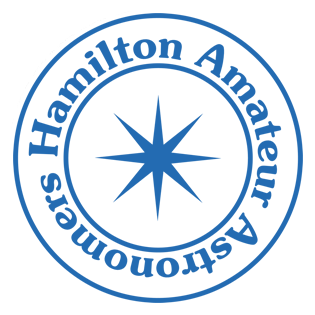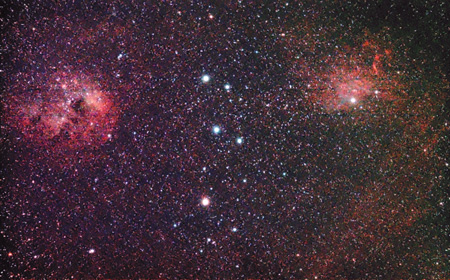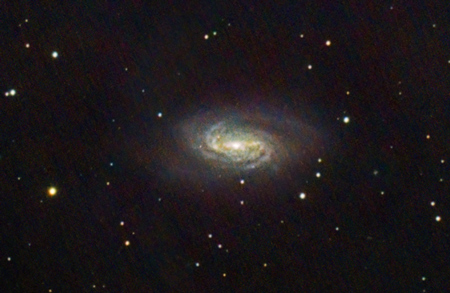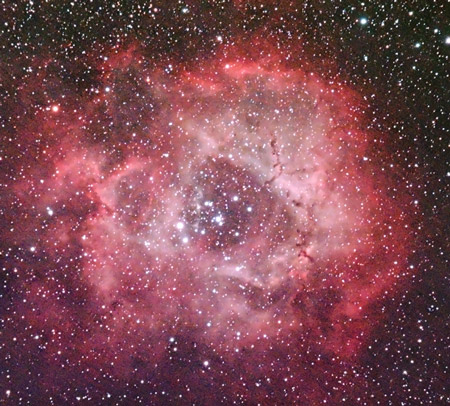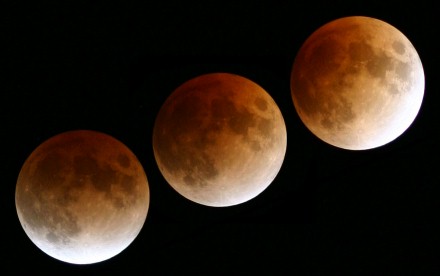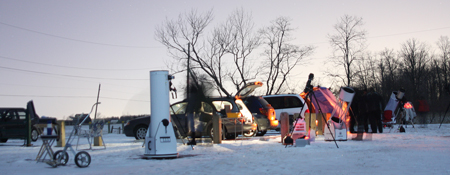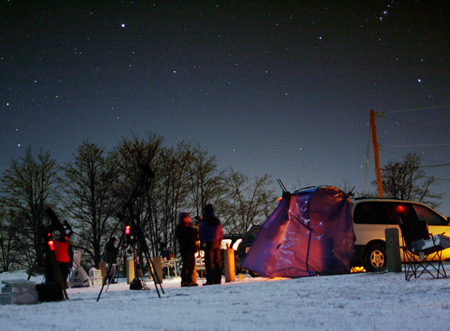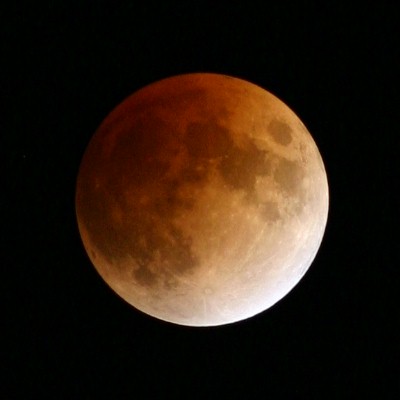Our HAA members were true to form, braving cold and ice, to set up numerous scopes, binoculars and other equipment, at the Binbrook alternate site.
I was impressed by the clear skies and view of Orion even from my car
as I drove to Binbrook. Unfortunately I could not be there early… as i had another meeting to attend, but when I arrived, the eclipse was about 3/4 total, and there was a convenient parking spot for my car in the front row.
I arrived to find about 14 cars and as many scopes set up in the field adjacent to the parking lot. All the regulars were there, as well as more than a dozen guests who came to see the eclipse first-hand, so to speak.
As has been mentioned, the eclipse is great to see with just about any equipment, including just your unaided vision, but the prospect of an hour of comparative dark skies during such a full-moon-induced clear spell was irresistible to me.
John provided not only an excellent pair of binoculars on a parallelogram so anyone could see the view, but also a keen commentary on what to look for at each stage of the eclipse. He pointed out that there’s a strip of the moon between the partial part and the total part which actually looks bluish, due to the earths ozone layer absorbing the red light from the direct illumination of the sun.
Deeper into the Earth’s umbra, the moon looks reddish, lit by sunsets from all parts of the world at the same time.
I thought about the sun’s elevation below the horizon… as seen from the moon, even the sun which just disappears behind one side of the earth is only 2 degrees (like the view of a sunset 8 minutes old) below the horizon on the other side.
So indeed the perimeter of the earth must look spectacular from the moon when the earth eclipses the moon.
I wondered why we don’t have any cameras on the moon for just such an occasion. I seem to recall the next x-prize is for landing a rover on the moon and driving it around. With any luck they will put an upward facing camera (with appropriate shielding from the sun) on it, and we can have an earthcam vantage point.
I brought my trusty Sky Quality Meter (SQM) and took a reading on arrival. The zenith at 9:45 PM was registering 19.50 (magnitudes per square arcsecond) which is actually not so good. Shining straight at the moon registered 19.01.
Even with the moon eclipsed, the zenith still read 19.75, so I would have to say that even the eclipsed moon, the light reflecting from the snow covered ground, and the residual sky-glow of surrounding communities still added up to about an extra magnitude, as we usually get about 20.5 at Binbrook on dark nights.
I set up the GWS as the eclipse wore on, hoping to catch a glimpse of a few Deep Sky Objects during totality. In particular, I wanted to view M49, but Saturn would also be out and was worth the drive just for that.
Several members had goto scopes set up, and were tracking nicely.
I saw M79, a globular close to the horizon, in Heather’s scope.
M42 had the appearance of a dark nebula in front of a bright nebula.
Jim recorded a video of the moon during the approach to totality.
He also crafted an excellent warm-up tent, with a gas heater and a supply of tim-bits, under the hatch of his minivan. Anyone who was feeling the cold could duck in there for a few minutes and emerge re-energized and toasty warm.
Several members took still photos of the moon from various equipment. Looking forward to viewing their galleries in the next few days.
While the moon was eclipsed, we also were able to tour the sky. Saturn was ideally positioned, and showed 3 tiny sharp moons close-in to the planet, and perhaps 2 more far out. In the FFI with a 13 mm Ethos eyepiece, I could, (once told to look) make out the 3 moons.
Its kind of neat being able to look all around in the eyepiece and see the rest of the sky.
In the GWS I could also see the 3 moons, with a 26 mm 4000 series eyepiece and a “Big Barlow” – Effectively also a 13 mm eyepiece.
Once the moon came out of the umbra, the background brightened up and i could no longer make out the closest of Saturn’s moons in the GWS, but still could see it in the FFI… (I need to clean the GWS mirrors, it’s true).
Saturn was only about 4 degrees from the moon by then, and some moonlight was shining into the GWS and reflecting off the dust on my mirrors, but that’s another story.
My toes were getting pretty cold towards midnight.
It’s true all the advice about dressing warmly. I had on summer clothes and a decent coat, and my boots were safely at home,
but I maintained circulation, literally and figuratively, by making numerous trips to different scopes and sampling the views.
We packed up at about 11:45 PM and reconvened at Tim Hortons on Nebo Road. Excellent conversation and discussions persisted well past 1:30 AM, which is part of the reason HAA is such a great club.
Images By KerryLH
As you can see, I ran out of heat before the end and unfortunately stopped imaging before it was totally over. It was just soooo cold and I couldn’t bare to snap another frame.
Link to the large version: http://www.weatherandsky.com/main.php?g2_view=core.ShowItem&g2_itemId=1135&g2_imageViewsIndex=3
I think I captured that occultation star… am I right?
THe entire gang.. wait a minute where did everyone go???
Wow look at all the stars… totality just ending
Images by Don Pullen
(My first attempt at AP with the Canon 40D so be gentle with the comments.)
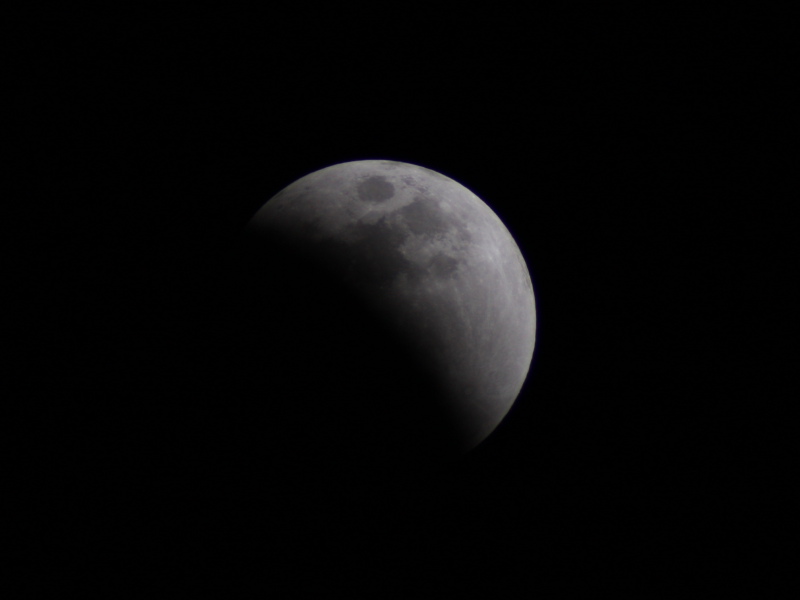
Eclipse under way
Orion Belt stars with nebula through 100mm f/5 achro scope and Canon 40D at prime focus, 30 sec exposure at ISO 200.
Another group shot. 40D Night portrait mode, 50mm f1.8 lens.
Hopefully some more later once I figure out how to process the other images I captured.
